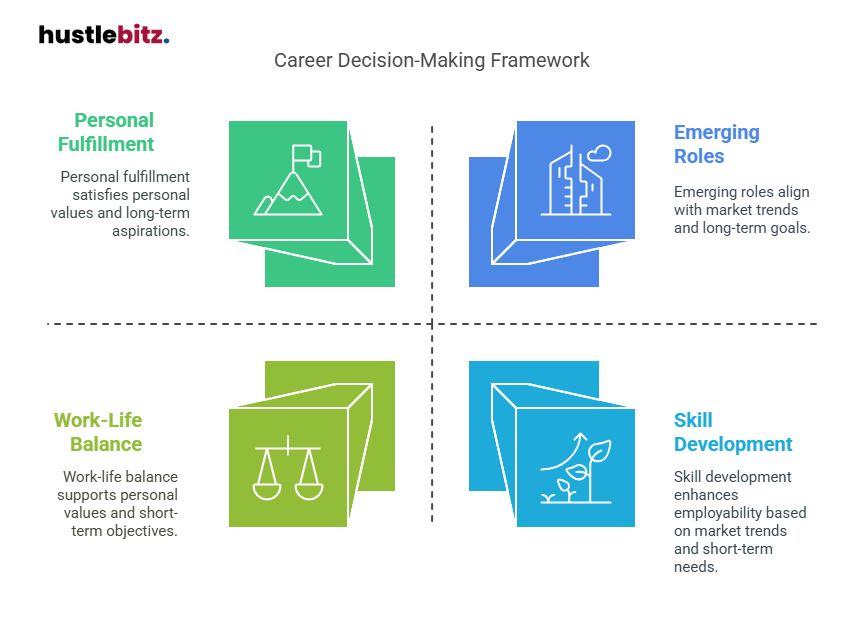Mapping the path to career success involves comparing various options that align personal values, skills, and market demands. Understand the balance between job market needs and individual passion for fulfillment. Evaluate the relevance of skills and experience, and consider the merits of traditional employment versus freelancing. Analyze education requirements and certifications that can enhance employability. It’s also essential to assess short-term versus long-term goals and the delicate balance between salary and job satisfaction. Additionally, consider the benefits and drawbacks of remote work compared to in-office roles. Explore these elements further to gain a clearer perspective on your career journey.
Key Takeaways
- Align career options with personal values and long-term goals for sustainable satisfaction and fulfillment.
- Conduct market research to identify industry trends, emerging roles, and skill-demand intersections for informed career choices.
- Balance short-term goals with long-term aspirations to maintain motivation and adaptability in career progression.
- Consider the pros and cons of traditional jobs vs. freelancing to find the right fit for work-life balance and personal preferences.
- Prioritize continuous skill development and experiential learning to enhance employability and adaptability in a dynamic job market.

Comparing Career Path Options

When evaluating career path options, how do various industries and roles align with your personal values and long-term goals? Understanding this alignment is crucial for making informed career transitions.
Begin by conducting thorough market research to identify industry trends and emerging roles that resonate with your aspirations. This foundational step helps you discern which fields offer the growth and fulfillment you seek.
Next, consider the significance of networking strategies and mentorship opportunities. Building relationships within your desired industry can provide valuable insights and guidance, enhancing your personal branding. Engaging with experienced professionals can illuminate potential career paths and help you cultivate essential emotional intelligence, a key asset in navigating workplace dynamics.
Job shadowing is another effective way to gain firsthand experience in various roles. This practice can clarify day-to-day responsibilities and workplace culture, aiding in your skill development.
Moreover, examine how each career option supports your work-life integration goals. A role that aligns with your lifestyle preferences is more likely to foster long-term satisfaction.
Job Market vs Passion

Balancing job market demands with personal passion is essential for achieving long-term career fulfillment and success. Professionals today face the challenge of aligning their passions with the realities of market demand. Understanding industry trends can help individuals identify areas where their skills and interests intersect with high-demand careers, enabling them to navigate the job landscape more effectively.
Passion alignment is crucial, as pursuing a career that resonates with personal values can significantly enhance job satisfaction. However, individuals must also consider the opportunity cost of their choices. Opting for a high-stability job that does not align with one’s passion may yield immediate job security but could hinder long-term career fulfillment. Conversely, pursuing a passion-driven career might involve risks, such as fluctuating job stability or lower initial pay.
Skill development is vital for both paths; enhancing one’s abilities can lead to greater job satisfaction whether in a passion-driven role or a market-demand position. A long-term vision that considers both personal aspirations and market realities can help individuals make informed decisions. By evaluating potential career paths against these two critical dimensions, professionals can create a roadmap that fosters both job stability and personal fulfillment.
Ultimately, achieving a harmonious balance between job market demands and personal passion is key to realizing a successful and satisfying career. This approach not only promotes individual growth but also contributes to a more engaged and productive workforce.
Skills vs Experience: Key Differences

Understanding the key differences between skills and experience is essential for professionals seeking to enhance their career prospects and effectiveness in the workplace.
Skills are the specific abilities and knowledge that enable individuals to perform tasks effectively, including both technical expertise and soft skills. A skills assessment can help identify areas of strength and opportunities for skill development, which are crucial for job readiness in any industry.
Conversely, experience refers to the practical application of skills through real-world scenarios, often acquired through roles in various settings. Experience acquisition is vital, as it not only solidifies the application of skills but also builds a portfolio of achievements that demonstrate industry relevance. While skills can often be transferable across different roles and industries, experience is typically more contextual, shaped by specific environments and challenges faced.
Moreover, experiential learning opportunities—such as internships, volunteer positions, and mentorship opportunities—play an essential role in bridging the gap between theory and practice. They provide individuals with hands-on experiences that enhance their understanding and adaptability.
Ultimately, both skills and experience are critical components of career advancement. Professionals must focus on continuous skill enhancement while seeking out diverse experiences to remain competitive and effective in their fields. Balancing the development of transferable skills with relevant experience will equip individuals with the tools necessary for long-term success in their chosen careers.
Traditional Jobs vs Freelancing
The choice between traditional jobs and freelancing significantly impacts an individual’s career trajectory, work-life balance, and financial stability.
Traditional employment typically offers job security, a predictable income, and benefits such as health insurance and retirement plans. This stability can provide peace of mind, especially for those with families or significant financial commitments. However, traditional roles may limit project diversity and the ability to pursue personal interests.
In contrast, freelancing provides unparalleled flexibility, allowing individuals to choose projects that align with their skills and passions. This option fosters work-life balance, enabling freelancers to set their schedules and potentially work from various locations. However, the trade-off often involves income variability and the necessity of developing self-promotion strategies to attract clients. Building strong client relationships becomes essential, as these connections can lead to repeat business and referrals.
Freelancers also enjoy diverse project opportunities, which can enhance their skill development and keep their work engaging. However, the need to constantly adjust to market demand can create pressure, requiring freelancers to invest time in networking opportunities and staying current with industry trends.
Ultimately, the decision between traditional jobs and freelancing hinges on an individual’s priorities, risk tolerance, and career goals. Those who value stability and structured growth may gravitate toward traditional roles, while those seeking autonomy and a varied work experience might find freelancing more rewarding. Each path has unique advantages and challenges that must be carefully considered.
Career Growth: Industry Comparison

Career growth varies significantly across different industries, influenced by factors such as market demand, technological advancements, and organizational structures. In sectors like technology and healthcare, rapid innovation creates diverse opportunities, necessitating robust networking strategies and a proactive approach to professional development. Engaging in job shadowing can provide invaluable insights into specific roles, helping individuals navigate potential career transitions effectively.
The importance of mentorship cannot be overstated; seasoned professionals often impart crucial leadership skills and industry trends that can accelerate career advancement. In competitive fields, personal branding becomes essential—individuals must articulate their unique value propositions to stand out. Conducting thorough market research can help professionals align their career goals with industry demand, ensuring they remain relevant and competitive.
Work-life balance is another critical consideration that varies by industry. For instance, while some sectors may promote flexible schedules, others may demand longer hours, impacting overall career satisfaction. Understanding these dynamics enables individuals to make informed decisions about their career paths.
As industries continue to evolve, the ability to adapt and embrace change is vital. Professionals should remain agile, continually reassessing their skills and seeking opportunities for growth. By leveraging mentorship, honing leadership abilities, and staying attuned to industry trends, individuals can map a successful career trajectory that aligns with their personal and professional aspirations.
Ultimately, a comprehensive approach to career growth ensures sustained success across diverse industries.
Corporate vs Entrepreneurial Careers

Navigating the choice between corporate and entrepreneurial careers involves assessing individual preferences, risk tolerance, and long-term goals, as each path offers distinct advantages and challenges.
Corporate careers often thrive within established corporate cultures that provide job stability, structured resource allocation, and clear leadership styles. Employees in these environments benefit from predictable income, comprehensive benefits, and professional development opportunities, making it an attractive option for those seeking security.
Conversely, an entrepreneurial career fosters an entrepreneurial mindset characterized by innovation opportunities and a more flexible work-life balance. Entrepreneurs face a high degree of uncertainty, requiring rigorous risk assessment and a willingness to embrace failure as a learning tool. The scalability potential of a startup can be significant, yet it demands relentless dedication and savvy networking strategies to build essential connections that drive growth.
While corporate employees may engage in collaborative decision-making processes, entrepreneurs must adopt a more autonomous approach, often leading teams with varying leadership styles.
The choice between these two career paths ultimately hinges on personal values and aspirations. For those prioritizing stability and a clear career trajectory, corporate roles may be more suitable. However, individuals who are passionate about innovation and are willing to navigate the complexities of entrepreneurship may find fulfillment in creating their ventures.
Understanding the nuances of both career paths enables individuals to make informed decisions that align with their unique goals and aspirations.
Comparing Education and Certification

Understanding the distinctions between corporate and entrepreneurial careers extends to the educational pathways and certifications that can enhance professional opportunities in each field. Both sectors value education, but their requirements and benefits may differ significantly. Corporate environments often emphasize formal degree requirements, while entrepreneurship may prioritize practical skills and experiential learning.
Education pathways can include a variety of options such as:
- Vocational training: Focused on specific skills applicable in various trades.
- Degree programs: Offering comprehensive knowledge and often required for corporate roles.
- Online courses: Providing flexibility and accessibility for continuous learning.
- Certification programs: Validating skills and knowledge in specialized areas.
The benefits of certification are particularly pronounced in today’s fast-paced job market. Certifications can serve as a means of skill validation, showcasing one’s commitment to professional development and adherence to industry standards. For individuals undergoing career transitions, certifications can bridge gaps in knowledge and enhance employability.
Additionally, lifelong learning is essential in both fields. Engaging in professional development through continuing education, whether via online courses or workshops, is crucial for staying competitive. As industries evolve, the ability to adapt through education and certification becomes a key driver of success.
Thus, understanding the educational pathways and certification benefits is vital for anyone seeking to navigate a successful career, whether in a corporate setting or as an entrepreneur.
Short-Term vs Long-Term Goals

Establishing a clear distinction between short-term and long-term goals is essential for effective career planning and achieving sustained success. Short-term objectives, typically set within a one to three-year timeframe, serve as stepping stones toward a broader long-term vision that may extend beyond five years.
These short-term goals often include obtaining specific skills, certifications, or completing projects that align with career milestones, fostering personal development and enhancing one’s professional portfolio.
Effective goal setting involves aligning short-term objectives with long-term aspirations. This alignment ensures that each achievement contributes meaningfully to the overarching vision. Motivation factors play a crucial role in maintaining focus and enthusiasm, as small wins provide a sense of progress and accomplishment.
Achievement tracking methods, such as regular reviews and reflections, help assess progress and adjust strategies as necessary.
Furthermore, adaptability skills are vital in navigating the dynamic landscape of career development. The ability to pivot and adjust both short-term objectives and long-term vision in response to changing circumstances can significantly impact success measurement.
Timeline planning is essential in this process, allowing individuals to allocate resources effectively and prioritize tasks.
Balancing Salary and Satisfaction

Achieving career success involves not only setting and reaching goals but also finding the right equilibrium between salary and job satisfaction, as both elements significantly influence long-term fulfillment and engagement in one’s professional journey. Striking this balance is essential for maintaining intrinsic motivation and ensuring career fulfillment over time.
While financial stability is important, it should not overshadow the pursuit of a supportive workplace culture and job security.
To effectively balance salary and satisfaction, consider these factors:
- Salary Negotiation: Engage in discussions about compensation packages that reflect your skills and market value, ensuring your financial needs are met.
- Employee Benefits: Evaluate the entirety of compensation, including health benefits, retirement plans, and other perks that contribute to overall job satisfaction.
- Work-Life Balance: Prioritize positions that acknowledge personal time and flexibility, as they can enhance both productivity and happiness.
- Workplace Culture: Seek environments that align with your values and foster a sense of belonging, as positive interactions with colleagues can significantly enhance job satisfaction.
Ultimately, achieving a balance between salary and job satisfaction is vital for long-term career success. Individuals should regularly assess their priorities, ensuring that financial considerations do not compromise their passion and engagement in their work.
Remote vs In-Office Careers
Weighing the benefits and challenges of remote versus in-office careers is essential for professionals seeking to align their work preferences with their personal and professional goals. Remote work offers notable flexibility benefits, allowing employees to tailor their schedules to enhance work-life balance. This flexibility can lead to increased job satisfaction; however, it may also introduce productivity challenges. Professionals can struggle with isolation effects, which can hinder employee engagement and overall motivation.
Conversely, in-office dynamics foster a collaborative environment where team collaboration is often enhanced through face-to-face interactions. Communication tools can bridge the gap in remote settings, yet they sometimes fall short of replicating the organic exchanges that occur in physical offices. For many, the immediacy and richness of in-person communication can facilitate clearer understanding and stronger relationships among colleagues.
When considering career advancement, both pathways present distinct opportunities and challenges. Remote work may limit visibility and networking possibilities, potentially affecting promotion prospects. However, companies increasingly recognize the value of remote talent, making it possible for remote professionals to advance their careers through exceptional performance.
Ultimately, the decision between remote and in-office careers hinges on individual preferences and priorities. Professionals must carefully evaluate how each option aligns with their aspirations for productivity, engagement, and career progression. Balancing these factors will guide them in navigating the evolving landscape of work and achieving their career success.
Final Thoughts
Navigating your career path involves carefully weighing various options and making informed comparisons. By aligning personal values, skills, and market demands, you can create a clear roadmap to success. Whether you prioritize job stability, passion, or flexibility, understanding the trade-offs between different career paths, such as traditional employment versus freelancing or remote versus in-office roles, will help guide your decisions. Ultimately, striking a balance between personal fulfillment, skill development, and professional opportunities is key to long-term career success.




